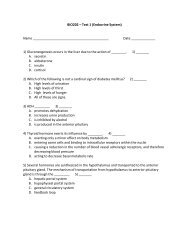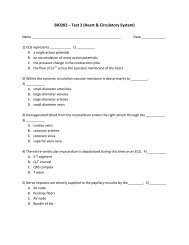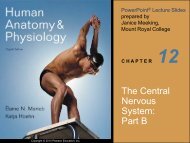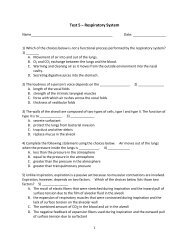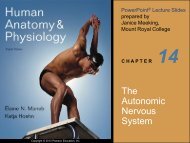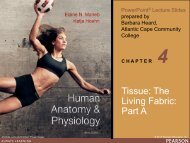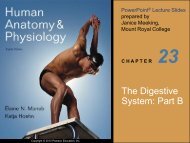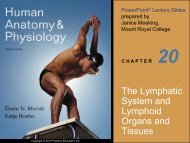Test 4 â Immune System (Chapters 20 & 21) Name ... - Next2Eden
Test 4 â Immune System (Chapters 20 & 21) Name ... - Next2Eden
Test 4 â Immune System (Chapters 20 & 21) Name ... - Next2Eden
You also want an ePaper? Increase the reach of your titles
YUMPU automatically turns print PDFs into web optimized ePapers that Google loves.
13) How are T cells “introduced” to antigens? 13) __________A. T cells bind to and phagocytose antigens.B. Antibodies immobilize the antigens for T cell recognition and destruction.C. Antigen-presenting cells link antigenic peptides to MHC proteins to which T cells willattach.D. T cells wait in the blood until an antigen collides with them and binds to their TCR.14) When antibodies develop against a person’s own cells, this is an example of a(n) ________.14) __________A. delayed hypersensitivityB. immediate hypersensitivityC. allergyD. autoimmune disease15) Small, yet complex, encapsulated organs associated with lymphatic vessels are termed________. 15) ________A. lymph folliclesB. axillary nodesC. lymph nodesD. lymphoid follicles16) Which statement or statements is/are false? 16) _________A. The respiratory burst produced by some macrophages releases, amongst other things,free radicals and provides a higher level of defense against internalized pathogenB. Monoclonal antibodies are made by fusing tumor cells and T lymphocytes.C. About 10 liters of fluid are lost to the tissue spaces every 24 hours and are returned tothe bloodstream as lymph.D. B and C17) Which statement is true? 17) _________A. Cytotoxic T cells bear CD4 molecules and recognize antigens that come from outside theAPC (exogenous antigens).B. Lymphoid tissue is distinguished from non-lymphoid tissue by the abundance ofreticular connective tissue.C. In general, lymphocytes reside permanently in lymphoid tissue, rarely moving to otherparts of the body.D. A given pathogen will provoke either a cell-mediated response or an antibody-mediatedresponse but not both.
18) The mechanism of the "lethal hit" of cytotoxic T cells and NK cells involves a protein orproteins called _________. 18) _________A. perforinB. defensinC. granzymesD. A and C19) The most important role of the spleen is to provide a site for _________. 19) _______A. fat metabolismB. storage of blood plateletsC. blood-cleansing functions (e.g. removal of old red blood cells & platelets)D. lymphocyte proliferation and immune surveillance and response<strong>20</strong>) The thymus ________________. <strong>20</strong>) _______A. lacks folliclesB. directly fights dangerous antigensC. functions primarily during adult lifeD. is the site where B cells become immunocompetent21) Somatic recombination, the one-time joining of different segments to DNA, ___________.21) ________A. occurs in T and B cellsB. is used to form unique receptor genesC. causes cell apoptosisD. A & B22) The IgG antibody protein consists of how many different protein subunits?22) _______A. 2B. 3C. 4D. 823) The respiratory burst produced by some macrophages releases, amongst other things, freeradicals and provides a higher level of defense against internalized pathogens. True or False?23) ____________24) Which is not an autoimmune disease? 24) _______A. Rheumatoid arthritisB. LupusC. Type II diabetesD. Multiple Sclerosis
25) The molecules presented by MHC receptors are __________. 25) _________A. nucleic acidsB. carbohydratesC. peptidesD. proteins26) Interferons ___________. 26) _________A. help protect cells that have not yet been infected by virusesB. interfere with viral replication within cellsC. are part of the innate immune responseD. All of the above.27) In the thymus, T cells that recognize self MHC and self-antigen are _______________.27) _______A. allowed to become immunocompetent cells outside of the thymusB. not allowed to leave the thymus and they dieC. able to become helper T cellsD. then tested to see if they react to non-self antigen28) An antigenic determinant in humoral immunity is ___________. 28) __________A. a specific region on a 3 dimensional structure that is bound by an antibodyB. a protein held by a MHC moleculeC. a peptide that is recognized by T cellsD. the residual material after phagocytosis that binds to MHC molecules29) Which of the following statements regarding NK cells is a false? 29) _______A. NK cells are a type of lymphocyte.B. NK cells attack cancer cells and virus-infected body cells.C. NK cells attack cells that lack the correct surface receptors.D. NK cells are phagocytic.30) The key point(s) about T cell activation is that it __________. 30) ___________A. requires no co-stimulatory signalsB. requires antigen bindingC. involves at least two cellsD. B & C31) The white pulp found around arteries of the spleen contains large numbers of ________.31) ______A. lymphocytesB. macrophages & red blood cellsC. plateletsD. NK cells
32) Which of the following would not be classified as a lymphatic structure? 32) ________A. pancreasB. tonsilsC. spleenD. Peyer's patches of the intestine33) Cellular ingestion and destruction of particulate matter is called phagocytosis. True orFalse? 33) __________A. TrueB. False34) The thymus is most active during __________. 34) __________A. fetal developmentB. middle ageC. childhoodD. old age35) Which lymphatic structure drains lymph from the right upper limb and the right side of thehead and thorax? 35) ______A. cisterna chyliB. lumbar trunkC. thoracic ductD. right lymphatic duct36) The lymphatic capillaries are ________. 36) ______A. less permeable than blood capillariesB. as permeable as blood capillariesC. completely impermeableD. more permeable than blood capillaries37) Antibodies that act against a particular foreign substance are released by ________.37) ______A. T lymphocytesB. medullary cordsC. plasma cellsD. lymph nodes38) Lymph leaves a lymph node via ________. 38) _________A. efferent lymphatic vesselsB. the cortical sinusC. afferent lymphatic vesselsD. the subscapular sinus
39) Which of the following is not a barrier to bacterial invasion? 39) __________A. MucusB. Lysozyme in tearsC. SalivaD. Interferon40) Select the correct statement about lymph transport. 40) ________A. Lymph transport is only necessary when illness causes tissue swelling.B. Lymph transport depends on the movement of adjacent tissues, such as skeletalmuscles.C. Under normal conditions, lymph vessels are very high-pressure conduits.D. Lymph transport is faster than that occurring in veins.41) When activated T helper cells release cytokines that activate T cytotoxic andB cells. True or false? 41) ____________A. TrueB. False42) Select the correct statement about lymphocytes. 42) ________.A. Just like B cells, activated T cells become plasma cells too.B. Macrophages can be thought of professional antigen presenting cells.C. T cells are the only form of lymphocyte found in lymphoid tissueD. None of the above.43) Select the correct statement about lymphoid tissue. 43) ______A. Lymphoid tissue is predominantly reticular connective tissue.B. Lymphoid macrophages secrete antibodies into the blood.C. Once a lymphocyte enters the lymphoid tissue, it resides there permanently.D. T lymphocytes act by ingesting foreign substances.44) Lymphoid tissue that appears as a swelling of the mucosa in the oral cavity is called a(n)________. 44) ___________A. Peyer's patchB. thymusC. tonsilD. appendix45) Which of the following represents a logical sequence of structures that contribute to thereturn of fluid into the blood via the lymphatic system? 45) __________A. Blood capillaries, arteries, lymphatic vessels, subclavian veinB. Arteries, lymphatic vessels, blood capillaries, subclavian veinC. Arteries, blood capillaries, lymphatic vessels, subclavian veinD. Subclavian vein, arteries, blood capillaries, lymphatic vessels
1) B2) C3) B4) D5) D6) D7) B8) D9) A10) C11) D12) C13) C14) D15) C16) D17) B18) D19) C<strong>20</strong>) A21) D22) A23) A24) C25) C26) D27) B28) A29) D30) D31) A32) A33) A34) C35) D36) D37) C38) A39) D40) B41) A42) B43) A44) C45) C



